Widow-and-orphan stocks are shares of companies known for their reliability in paying dividends and stability in market price. These are typically large, well-established firms, often in traditional sectors like utilities or consumer staples. The name widow-and-orphan comes from the historical idea that these stocks are safe enough for individuals who need a steady, reliable income, such as widows or orphans. In the modern context, they are a popular choice for investors looking for stability and consistent income from their portfolios. Widow-and-orphan stocks, also known as defensive stocks, are typically characterized by the following features: Stable Dividend Payouts: These stocks belong to companies with a long track record of regular and reliable dividend payouts, making them attractive to income-focused investors. Large, Well-Established Companies: Widow-and-Orphan stocks usually belong to mature, large-cap companies that operate in established industries. These companies have typically been in operation for many years and have a history of stability and steady performance. Lower Volatility: These stocks generally experience less price volatility than the broader market. This is because the companies are often in industries less sensitive to economic cycles, such as utilities, consumer staples, or healthcare. Steady Demand: Companies that offer Widow-and-Orphan stocks operate in industries with steady demand for their products or services, regardless of the overall economic situation. This leads to predictable and stable earnings. Strong Financial Health: Widow-and-Orphan stocks are often associated with companies with strong balance sheets, manageable levels of debt, and healthy cash flows. This financial stability supports their ability to pay dividends consistently. Lower Growth: While these stocks provide stability and consistent dividends, they typically do not offer high capital appreciation. Their growth rate is often slower than stocks in emerging or rapidly growing industries. Widow-and-Orphan stocks represent shares from companies known for their robust financial health, consistent dividend payments, and relative insulation from market volatility. These stocks, typically from mature, large-cap companies in stable industries, work by providing a reliable income stream to investors and acting as a defensive play in various market conditions. Here's how they work in more detail: The primary appeal of Widow-and-Orphan stocks is their propensity to provide a consistent and regular income through dividends. These companies have strong financial health and a track record of consistently paying dividends, making them attractive to investors who prioritize income over capital appreciation. As a result, even during economic downturns, these companies often maintain their dividend payouts, thereby providing a steady income stream for investors. Widow-and-orphan stocks have a lower risk profile than growth-oriented stocks or those from volatile sectors. Companies issuing these stocks often operate in sectors less susceptible to economic cycles, such as utilities or consumer staples, which can maintain demand regardless of the broader economic climate. This leads to more stable earnings and less price volatility, hence a lower risk profile. These stocks can counterbalance in an investment portfolio against more volatile or risky assets. In this way, they offer a diversification benefit, helping to smooth out returns and reduce overall portfolio risk. Given their steady dividends and relative stability, Widow-and-Orphan stocks are generally well-suited for a long-term investment strategy. Investors often hold these stocks for long periods to enjoy the compounding benefits of reinvesting dividends. Investing in widow-and-orphan stocks can be a valuable strategy for portfolio diversification. Since these stocks typically perform independently of volatile market conditions, they can help buffer a portfolio against severe market downturns. Another strategy is the dividend reinvestment plan (DRIP). This strategy involves automatically using the dividends paid out by the stock to purchase more shares, which can enhance returns over time through compounding. Widow-and-orphan stocks are typically held for long periods, often years or decades. The appeal of these stocks lies not just in their stability but in the power of compounded returns. Consistent dividend payouts can accumulate significantly over extended periods, particularly when those dividends are reinvested into buying more shares. Regular dividends can provide a steady income stream for investors, particularly retirees who require reliable income. This dividend payout, often on a quarterly or annual basis, serves as a form of regular income similar to the payout from a bond or interest from a savings account. The most significant benefit of widow-and-orphan stocks is the reliable income they generate through dividends. This income can provide a cushion in volatile market conditions and be a valuable source of income for those in or nearing retirement. Widow-and-orphan stocks also help lower overall portfolio risk. Because these stocks are typically less volatile, they can reduce the potential for significant losses during market downturns. These stocks can also offer stability in volatile markets. Because they are typically in industries with stable demand, their earnings—and, therefore, their stock prices—are less likely to fluctuate wildly in response to economic cycles. While the stability of widow-and-orphan stocks is a strength, it can also be a drawback. Because these stocks are in mature industries, they generally offer a different potential for rapid growth than stocks in emerging industries or sectors. Investors looking for high returns in a short period may find these stocks unattractive. While these stocks typically provide a stable dividend, there can be circumstances where dividends are cut or eliminated due to market conditions or poor company performance. This risk is generally lower with widow-and-orphan stocks, but it is still present. Like any other investment, there is a risk of over-concentration. If an investor holds too many widow-and-orphan stocks from the same sector, they can be exposed to sector-specific risks. When investing in widow-and-orphan stocks, one of the first things to consider is the company's dividend history. Companies with a long and consistent history of paying dividends are often a good indication of a reliable widow-and-orphan stock. Companies that exhibit robust cash flows, manageable debt levels, and consistent profitability are typically better positioned to sustain their dividend payments over time. A healthy balance sheet can indicate a company's ability to weather economic downturns without compromising its dividend policy. Additionally, a company's history of steady earnings can demonstrate its ability to generate profits consistently, further reinforcing its financial stability. Every investor has different risk tolerance levels. Widow-and-orphan stocks generally suit investors with lower risk and a steady income stream. However, those seeking higher growth may find these stocks too conservative. Lastly, market conditions play a role in the performance of widow-and-orphan stocks. While they're generally resilient during downturns, severe market distress can impact these companies and their ability to pay dividends. Widow-and-orphan stocks offer investors a range of benefits, including a steady income stream, lowered portfolio risk, and market stability. These stocks are characterized by stable dividend payouts, large, well-established companies, lower volatility, steady demand, and strong financial health. They work by providing reliable income and acting as a defensive play in various market conditions. Investment strategies involving widow-and-orphan stocks include portfolio diversification, dividend reinvestment, long-term holding, and income generation. While the stability and consistent dividends of widow-and-orphan stocks are advantageous, they may have lower potential for rapid growth, and the risk of market conditions impacting dividends is present. Investors should consider factors such as the company's dividend history, financial health, their own risk tolerance, and market conditions when making investment decisions. By carefully assessing these factors, investors can make informed choices about incorporating widow-and-orphan stocks into their investment portfolios.What Are Widow-and-Orphan Stocks?
Characteristics of Widow-and-Orphan Stocks
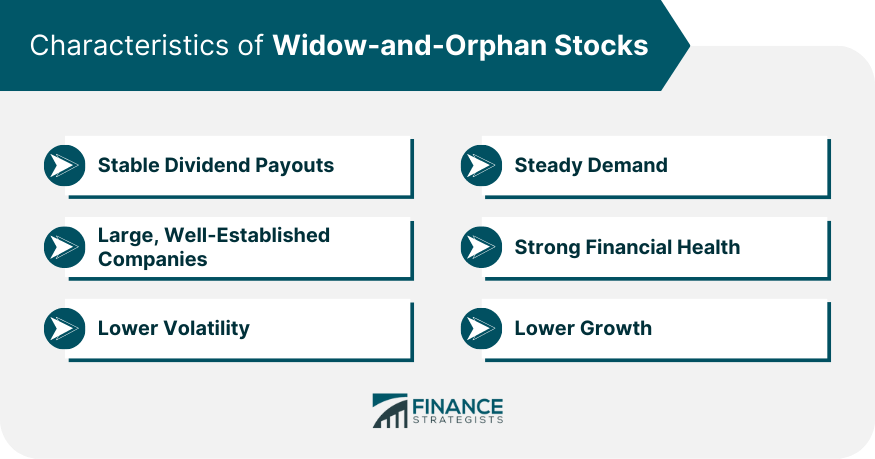
How Widow-and-Orphan Stocks Work
Stable Dividends
Lower Risk Profile
Portfolio Diversification
Long-Term Investment Strategy
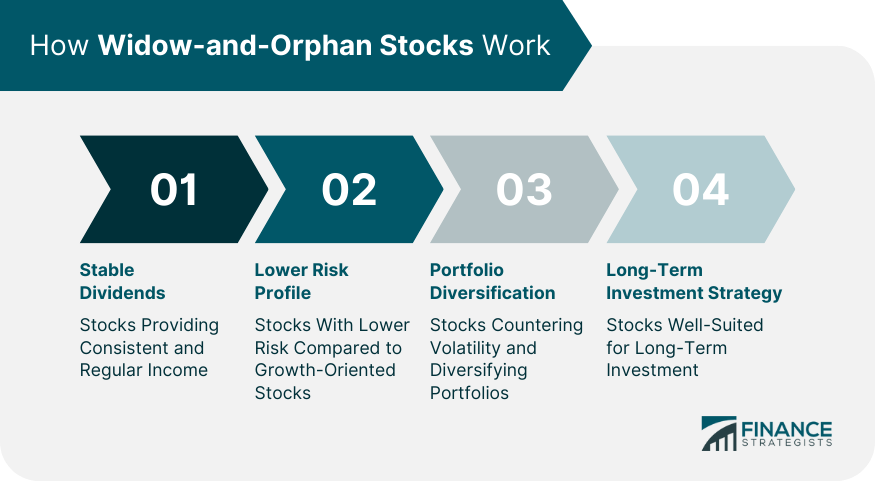
Investment Strategies Involving Widow-and-Orphan Stocks
Portfolio Diversification
Dividend Reinvestment
Long-Term Holding
Income Generation
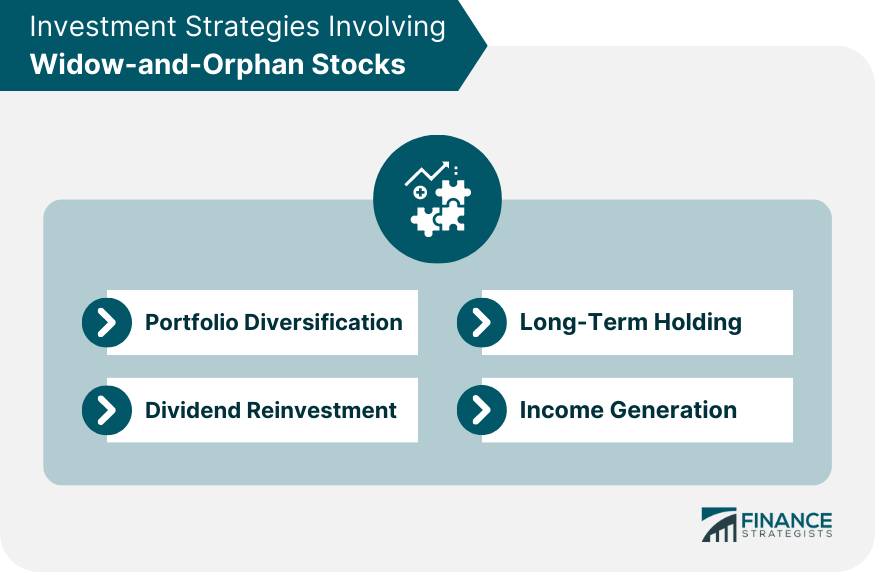
Benefits of Investing in Widow-and-Orphan Stocks
Steady Income Stream
Lowered Risk Exposure
Market Stability
Drawbacks of Investing in Widow-and-Orphan Stocks
Lower Potential for Rapid Growth
Market Conditions and Dividends
Risks of Over-Concentration
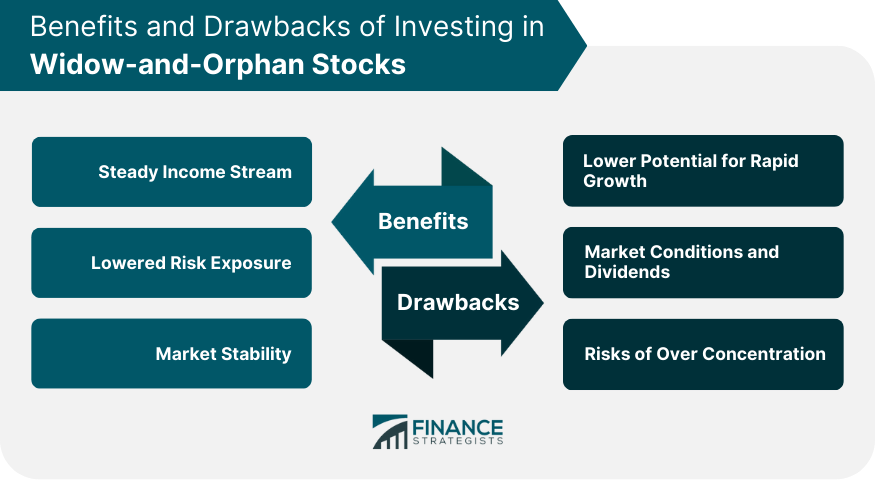
Factors to Consider When Investing in Widow-and-Orphan Stocks
Company's Dividend History
Company's Financial Health
Investor's Risk Tolerance
Market Conditions
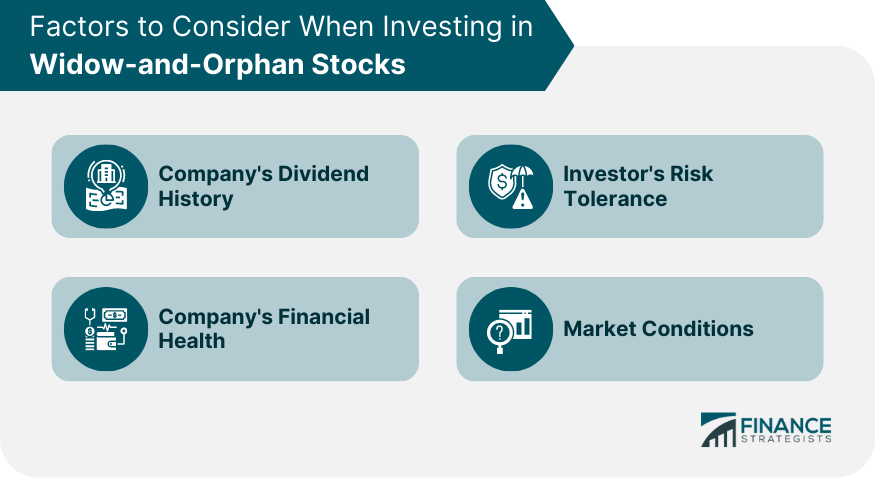
Conclusion
Widow-and-Orphan Stock FAQs
Widow-and-orphan stocks are dependable investments, often considered safe for vulnerable individuals, such as widows and orphans. These stocks belong to mature, well-grounded companies operating in essential sectors like utilities and consumer staples.
The advantages of investing in widow-and-orphan stocks include stable returns, low volatility, and reliable dividends. These stocks offer a predictable income source, lower price fluctuations, and consistent dividend payouts.
Widow-and-orphan stocks have limited growth potential compared to newer, innovative companies. They also depend on economic stability, as downturns impact their performance and dividend payments. However, they generally offer more stability compared to volatile stocks.
Widow-and-orphan stocks provide financial stability by associating with industries with robust and consistent demand. Companies in these sectors, such as utilities, generate steady revenues, ensuring predictable returns for investors.
Widow-and-orphan stocks suit risk-averse investors, individuals relying on regular investment income, and those seeking financial stability and reliable returns. They can serve as a valuable component in an investment portfolio for those prioritizing stable income over high-risk, high-reward investments.
True Tamplin is a published author, public speaker, CEO of UpDigital, and founder of Finance Strategists.
True is a Certified Educator in Personal Finance (CEPF®), author of The Handy Financial Ratios Guide, a member of the Society for Advancing Business Editing and Writing, contributes to his financial education site, Finance Strategists, and has spoken to various financial communities such as the CFA Institute, as well as university students like his Alma mater, Biola University, where he received a bachelor of science in business and data analytics.
To learn more about True, visit his personal website or view his author profiles on Amazon, Nasdaq and Forbes.











